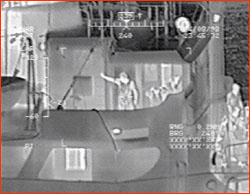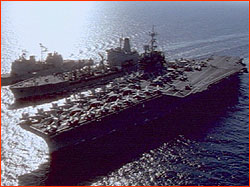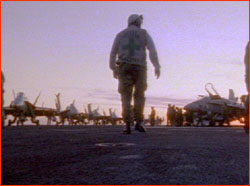 |
 |
 |
Part 3 | back to Part 2 In the meantime, what do you do with all these people while they wait? They fly around the clock. The primary mission for the pilots is called Operation Southern Watch, in which they patrol along the established "No Fly Zone," making sure nothing Iraqi this way comes. The "small boys," in addition to watching for any sign of a hostile launch, enforce the UN sanctions in an operation known as MIO (Maritime Interdiction Operations.) Anything that moves on the surface in the Gulf they look at (and believe me, they've got technology for doing it that would make your head spin). The point of the operation is to make sure that nobody violates the UN oil embargo, and they are very busy here. There are many "pirate" ships running along the Iranian coast (using Iran's territorial waters as a shield) to evade detection by the US forces. The cruisers and destroyers stop several ships every week and if they are suspicious, board them. If they find illegal oil on board, they confiscate the ship, unload the cargo, and give the ship back. The money from the oil goes to fund the UN operation out here. I watched the video footage of a US boarding party from the USS O'Brien taken two days before we got here; it's amazing. The video was shot at 2:00 a.m. from a Seahawk helo standing off at a distance of five miles...it looks like 2:00 p.m., not a.m.! In the video you see a rendezvous at sea, which made the helo pilot suspicious. He closed in to 500 feet off the vessel's stern, dropped a raft with a boarding party, and as the camera rolls you see the party get on the ship, run the length of the vessel, get into the wheelhouse and bring out the Master with his hands over his head. The ship, Iranian registry, was carrying a cargo hold full of illegal oil out of Iraq. What was amazing was that he was able to video the whole operation in the pitch black and in real-time show the pictures to the captain back on the O'Brien. The Captain made the call to board the ship based on the video he was looking at. The video looks like it was shot in broad daylight. I saw it while we were following the admiral on his tour of the "small boys" and he was being briefed by the O' Brien's skipper on the MIO operation. Very impressive. I can't tell you the name of the technology but you'll see it in the NOVA show. They gave me a copy of the boarding tape. Gotta go; we are off to the Indy for two days and then I get on the Tucson SSN (submarine) for four days. The submarine mission has changed completely since the last time I was on board the Michigan for NOVA. Then it was the Soviet Union. It's going to be interesting to see how they have adjusted their thinking to accommodate this new limited conflict scenario we are seeing here in the Gulf. Also, the average depth of the Gulf is 150 to 200 feet! That alone has got to cause problems for the Fast Attacks! By the way, because of this depth, if the aircraft carrier ever did sink, the entire bridge would still be out of the water! More later, Kirk
She steams at a published speed of 30 knots, an abstract number until you stand on the deck of this behemoth and watch oil wells going past like telephone poles on the highway! The airplanes ideally need 30 knots across the deck to take off and land; on most days the wind and the movement of the ship make it possible. But there are those odd days that the wind is still. With the Stennis that is not a problem; the captain can get her up to 30 knots just by putting the pedal to the metal and create 30 knots across the deck just using the speed of the ship! About the only impediment here in the Gulf is that if he's not careful at that speed he might bump into something unexpected like, say, Iran. That is not a joke; the pilots have to be careful when they launch that they don't overfly restricted air space like Iran's. Every time it happens a formal protest is lodged and things get sticky. The Stennis feels new, while the Indy has that well-oiled and greasy feeling of a man o' war. Of course the obvious difference to even the unschooled eye is the presence of 245 women on board the Stennis. What is remarkable is that on the Stennis they fit right in. If they all showed up on the Indy tomorrow, it would create havoc. It's a cultural thing, and the culture of the Stennis has known nothing else; funny isn't it?
There is one creature comfort new to this battle group that didn't exist on the John F. Kennedy in 1985 when last I filmed on a carrier: television. The ship has five channels: two carry ship announcements at all times, two get regular network hours (but no commercials!), and the last channel is video cameras trained at all times of the day and night on the flight deck. They record every landing and take-off from three different angles. They affectionately call it the "Airport Channel," and every room on the carrier has a television capable of tuning into it. It's a not-so-subtle reminder that every man and woman, every piece of machinery above and below decks is here to support those airplanes; that is what it's all about. If this thing can't fly its airplanes, for any reason, it's just a large target in the middle of the water; it serves no other purpose. Come to mention it, gotta run. We are filming a GQ (general quarters) tonight. It's a ship-wide alert and practice. Tonight's simulation—incoming missiles! Definitely better than Seinfeld! Kirk Kirk Wolfinger is an acclaimed producer and director whose work has won many awards, including the George F. PeabodyAward, the New York Film Festival award, and two prime-time Emmy nominations. Wolfinger's recent broadcasts have included two NOVA episodes, "Titanic's Lost Sister" and "The Beast of Loch Ness." Breakdown of a Battle Group | Women on the Carrier | Behind the Scenes Resources | Transcript | Site Map | Battle Alert Home Editor's Picks | Previous Sites | Join Us/E-mail | TV/Web Schedule About NOVA | Teachers | Site Map | Shop | Jobs | Search | To print PBS Online | NOVA Online | WGBH © | Updated October 2000 |
 Men from the US Navy
board a ship and check for illegal cargo.
Men from the US Navy
board a ship and check for illegal cargo.
 A section of the battle group.
A section of the battle group.
 Twilight aboard the Stennis.
Twilight aboard the Stennis.